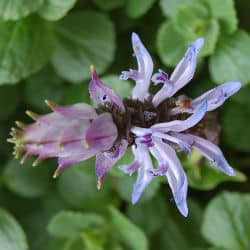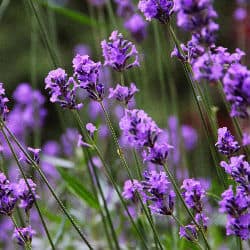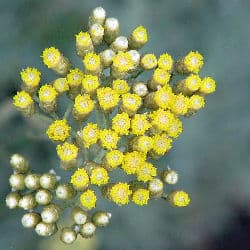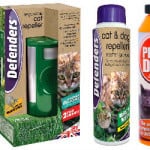Last updated on January 22nd, 2022
Our site is reader supported, this means we may earn a small commission from Amazon and other affiliates when you buy through links on our site.
Cat repellent plants, do they work?
Cats can become a little bit of a problem in gardens as they like to use our beds and borders as their own personal toilet, as any fellow gardeners will know.
The problem with cats is that they will dig up seedlings and young plants as well as dig holes in your beds and lawn. Of course, there are also the unfortunate experiences of getting it on your hands whilst gardening, which not only is disgusting, it is a health risk too, especially if you have children helping you out in the garden.
Cat poo can cause health problems and can contain a parasite known as Toxoplasma_gondii. This can cause serious health problems if you are exposed to it and it is particularly dangerous to pregnant women.
The top 7 plants that have shown to be a deterrent to cats
- Scaredy cat plant (Bred especially to deter cats, hence the name)
- Lavender (Also ideal for use in cooking recipes)
- Curry plant (Will grow in poor, dry soils)
- Rosemary (Can be used in cooking dishes)
- Rue (Very popular plant but is poisonous when eaten)
- Pennyroyal ( A member of the mint family)
We have more detailed information on these plants further down our article.
Quick note
Cat poo is also not good for the soil and cannot be used as a fertiliser as some gardeners may think. It can actually poison your soil and the plants in your beds and borders can begin to suffer and can die, so it is best removed immediately as you notice it.
Cat repellent plants
Cat repellent plants do not harm or scare cats, they only deter them from the area.
There are a few known plants that are shown to help deter cats, in the same way that some plants are attractive to cats. Although some plants do deter cats, it only works with around 70% of cats, as with most types of cat repellents.
The aroma of these plants is sensitive to cats and this is sometimes enough to stop cats from stopping and pooping around them. Please note it will not keep cats out of your whole garden and they will probably still walk by and pass through.
Scaredy cat plant (coleus canina)

The Scaredy Cat plant is one of the most popular cat repellent plants available. The odour it emits has a strong pee like smell, so it can also be unpleasant to humans too, however, some people have commented on how nice the smell is. Best planted directly in small problem areas or in a line to act as a barrier.
These plants grow well without much care and will grow in dry conditions. As cats tend to stay away from damp soil these plants can be the perfect plant to add to a dry spot where the cats usually go to the toilet.
- Coleus Canina is an easy-to-grow perennial that is bred with a very strong scent to keep cats out of your garden. These plants have neat grey-green leaves and produce lavender-like flowers, with small pale blue petals.
- As well as being a deterrent to cats, they also make this an attractive addition to borders and containers. At its most effective when grown in full sun and when fully established, these plants are undemanding and surprisingly drought tolerant.
- With this listing you will receive three strong plants in 10.5cm pots, ready to plant.
Lavender

Lavender is a type of herb plant that is popular with gardeners both in the UK and USA and it grows into a small shrub of approximately 30cm (1ft) tall. It has a pleasant, strong and sweet smell but fortunately, unlike us, most cats actually find it unpleasant so it can be effective in deterring the local cats.
Lavender grows well in poor and moderate soils and is drought tolerant so is ideal in dry areas of the garden. Perfect for planting in rows to act as a barrier or as single plants between plants and shrubs. Being evergreen, unlike the Scaredy Cat plant, it acts as an all year round cat repellent.
Lavender also grows well in pots so it can be moved around the garden to the spots where the cats are pooping.
Buy from Thompson & Morgan
Buy from Yougarden.com
- Hidcote English Lavender Plants in 9CM POTS with good roots system
- Cold Grown in Lincolnshire ready to thrive in the Spring
- Top Quality Plants, ideal for attracting bees and butterflys
- Top Quality Plants COLD GROWN IN LINCOLNSHIRE
- Grows up to about 50cm tall.
Curry Plant – Helichrysum angustifolium or Iitalicum

The curry plant is often sold as a shrub and it produces yellow flowers and grows wild in Mediterranean areas. As the name suggests it smells like curry, which cats are known to dislike the smell of, making it the perfect cat deterrent plant. It doesn’t have any culinary uses and cannot be used as a herb. It grows between 30-50cm tall with a similar spread, however, can be pruned back in spring. This plant also grows well in poor, dry soils.
- Established herb plug plants
- Great in a pot as well as a herb garden
- Amazing value
- Highly Scented curry leaves
- Great for cooking
Rosemary – Rosmarinus officinalis
Rosemary is usually grown for its culinary uses as it is a very popular garden herb with a nice sweet scent that is very pleasant. Cats, however, are sensitive to the smell and do not like being around it, so it makes for a good natural repellent with the extra benefit of you being able to use it in cooking recipes.
Rosemary can be grown in pots as well as in beds and borders. It prefers a dry site to thrive and will grow in poor soil. Rosemary is an evergreen plant making it an ideal choice as it does not need replacing every season as some plants do. If your soil is damp, wet soil then you would probably not succeed with this plant.
- Strong Plant In A 1.5 Litre Pot
- Ready To Be Planted Directly In the Garden Or Patio Pots
- Perfect For use in The Kitchen When Cooking
Rue – Ruta Graveolens
Rue is a shrub that has proven to deter cats and grows in dry soils, Rue is poisonous when eaten so care should be taken when using this plant. It is not very popular as a plant but has shown good cat repellent capabilities.
Pennyroyal
Pennyroyal is one of the smallest varieties of the mint family and was once used in cooking. Nowadays it becomes known as an effective plant to deter cats. It is also known as pudding grass.
Conclusion
The plants above are all effective at deterring cats and as such are good cat repellent plants. The Scaredy Cat plant, Lavender and the curry plant have proved the most popular but there are many other plants that may be effective. It is hard to say which one will work the best as some plants thrive better in different locations, plus the size of the area you are trying to deter them from will also have an effect too. All the above plants deter cats because of their smell and planting them in rows often works well as a physical barrier.
Some other plants and shrubs that are worth mentioning are those with sharp thorns as they can be used to form a physical barrier and can be used to block areas where cats are known to travel through into your garden.
Prickly bushes ideal for deterring cats by forming a physical barrier
Hawthorn is a deciduous shrub with sharp thorns that if left not pruned would grow into a very large bush. Ideal for forming hedging and filling in any gaps in hedges that cats may be walking through.
Wild Rose (Rosa rugosa) has lots of sharp thorns and can also be used to form a hedge. They also produce some lovely flowers.
Bramble (blackberry) have very sharp thorns that cats will not walk through. The other advantage is that you get to pick the blackberry fruits off them in the summer. There are thornless varieties of Blackberry so if you are looking to deter cats it is best to ensure you don’t purchase one of these varieties by mistake.
Pyracantha is an evergreen shrub with long sharp thorns that can be planted as a shrub or as a hedge. It offers all year round colour and berries in late autumn. A beautiful shrub on which our very own website is named after.
Berberis is another shrub with many types available. These include both evergreen and deciduous varieties. Ideal for planting to deter cats in areas where cats are passing through into your garden. If you have a small area where cats are pooping you can also plant Berberis that will keep them from doing so.
One of my favourite Berberis plants is a variety called Berberis thunbergii ‘Harlequin’, you have a closer look at it on Amazon here.
Other amazing ways to deter cats
If plants are not really working for you or are simply not a suitable option, there are many different types of cat scarers available to try. These include sonic cat repellers, their devices make high-frequency noise that cats can hear but people cannot. There are also motion-activated water jets that detect cats and spray water automatically as well as cat repellent pellets such as Silent Roar.
If you are looking for the best cat scarer, check out our review here.
Last update on 2024-04-24 / Affiliate links / Images from Amazon Product Advertising API









